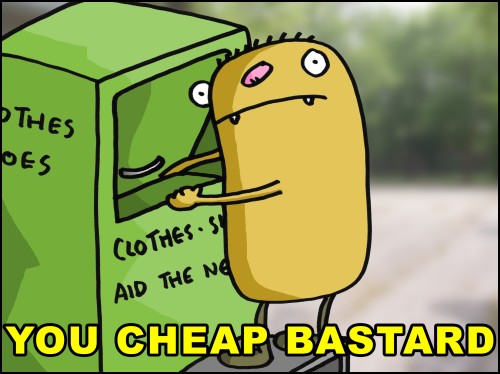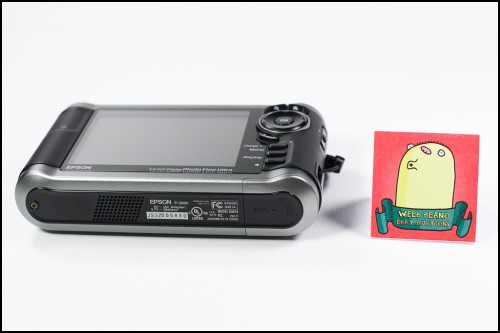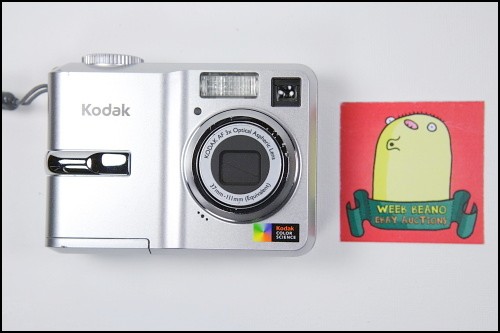Jul
19
11 Tips For Selling Your Used Stuff on Ebay

It seems that at some point, everyone has contemplated at least once trying to sell some of their unused but still valuable items on eBay. Some people never seem to get around to doing it. Some people are eBay professionals. Everyone also has their own different motivations. Some do it for the money, others do it to eliminate clutter. For me? I personally found it as a great outlet to fight that innate hoarder inside. Whatever your motivations may be, here are 11 tips which hopefully can be of use to you.
#1 – Don’t inflate your shipping charges

If you gouge people on shipping, this is what you are.
Some people advocate jacking up your shipping charges in order to try and make a extra buck. While this may work for specific, expensive items, it tends to not be as effective with commodity products.
Jacking shipping rates also is seen as an act of subtle douchebaggery and you may be costing yourself sales by doing it. Sources that advise shipping price inflation tended to do so prior to eBay implementing the change in their interface which lets you sort on prices including shipping.
It can be argued that psychologically, when people see fair shipping charges on an item, they may be more inclined to bid higher if involved in a bidding war.
#2 – Don’t lie

"Hurricanes don't never, ever hit here!"
There’s two kinds of lies- little white lies, and pure, utter bullshit. Little white lies are what gets your wife mad and puts you at risk of sleeping in the bathroom for a few nights, while pure, utter bullshit can earn you a nice, bloody divorce.
Both of these should be avoided like the plague when describing an item for sale. If there’s damage to something, be up front about it. I think that’s all I need to say about this sort of thing. Karma’s got a mean, wicked backhand. Don’t cry to me if she catches up to you. The only comfort which will be received is a nice, steady stream of public humiliation. Do the right thing.
#3 – If there is damage, take close-up shots of it

"Sir, we can have that out for you in a jiffy."
You may see a pattern here of not lying. Aside from the good karma you can rack up from not being a bullshit artist- it can be profitable too. So you may be trying to sell something, let’s say a fancy laptop computer- but it has a small gash in the LCD screen… instead of hiding that, describe the problem in detail and provide detailed pictures of it.
Your prospective buyer might actually not mind the damage and be looking for replacement parts from said laptop. Who knows. The world is a funny place, and for every few people who will gripe about the damage to the computer and move on, there might be a few who will overlook that as an issue and continue with the purchase- subconciously even motivated to bid higher due to the trust you as a seller convey by being honest.
#4 – Use a token

This is a sample token, next to a fancy gizmo thingy.
A token is merely something which identifies you that is put into the photo alongside your product. The token I use is merely an image that I drew, which was printed to a flat and paper stand format. A lower resolution image of the same image is also used as my eBay icon. This provides a level of consistency and trust.
Putting something into the photo looks a lot more convincing as proof that you actually own the object you are selling- especially if the item can be expensive. Compared to a watermark, which only is meant to protect an image from theft, a token is a sure-fire way to help identify you as the owner of the product. This can be helpful if you don’t have too many feedbacks when selling a specialized item.
#5 – State your terms clearly in the item description

Usually... having all the facts about a situation is a good thing.
The typical things you may want to state in your item description, particularly for higher value specialized products are the following:
- “This item sold AS IS” – This helps you prevent the inevitable encounter with some jackass who has bought something used and expects you to go out of your way to fix it as if it were brand new. “As is” sets the expectation that the product is being sold in its current condition, with whatever faults or caveats in its current condition being solely the responsibility of the buyer.
- State your refund policy clearly in the description. It may seem like something from the Department of Redundancy Department, but it couldn’t hurt. Just make sure that what you state in the auction is consistent with the eBay drop-down box during the auction listing phase.
- State EXACTLY what will come in your auction. Channel your latent anal-retentivity and list each and every item- part numbers if you really want. This way there can be no confusion about what is included and what isn’t.
#6 – Do ship to international customers

Printing packing slips... Shipping packages... You da man.
Something uniquely cultural to Americans seems to be the assumption that most international buyers are sleazebags from third-world hellholes looking to con you. If you truly believe this, you are really missing out on a lot of potential business. Shipping via USPS Priority Mail International is relatively painless and not that much more difficult than shipping domestically.
Understand that in many parts of the world, consumer goods are taxed much more. For example, with some camera manufacturers- the same exact digital SLR camera lens sold in the USA can be almost 50% more in the UK and Europe. By allowing worldwide shipment, you get the best of both worlds- you can sell certain used items at almost the cost you paid for them (or even more!)- and international buyers legitimately get a good deal from you.
#7 – Be savvy with the typical auction scams

Sometimes, to win is to not play.
Here’s a list of the typical scams that come around on eBay and be familiar with them.
- Shipping item as a gift: This is where the scammer tries to get you to send an item somewhere that is not a validated address. It almost always ends up being a different country which the buyer’s valid address is in. Do this, and you pretty much have pissed away your money.
- Paying for a friend overseas: This is a variation of the above scam.
- “Abort the auction, I’ll pay you right now”: This is where the buyer tries to get you to sell the item outside of the normal market confines of eBay. Don’t even think about trying this. Scammers typically use forms of payment which will initially allow transfer of funds- so it only LOOKS like the cheque or money order has cleared- but once found out, YOU will be the one left on the hook for the difference.
In short, the simple answer to deal with all of these is no, no, no. Repeat after me- No! No! No!
Still here? Excellent. You have survived my admittedly simple, but very painless “Don’t Be A Sucker School”.
#8 – Withdraw from your PayPal account quickly

Thank you for holding. Your call is very important to us.
Despite the ease and convenience that PayPal provides, they are NOT a bank (though they try to make their customers think they are), and therefore are not subject to the typical regulations that a financial institution would normally be held under.
For example, PayPal does not pay you interest for the duration in which they keep your money. They are simply not obligated to. In the past, they have occasionally performed shady transactions without any notice to the consumer- so it is important to regularly clear out your account without letting too much money accumulate.
Some of the usual things that PayPal tends to do are listed below:
- PayPal freezes an account over something they didn’t like in a credit report. It happened here- “Random Credit Check = $5000 Frozen”. Can you imagine a bank doing something like this?
- PayPal blocks personal transactions to and from the entire country of India. It’s true. I simply cannot make this sort of stuff up. PayPal had a grudge match with an entire country!
- PayPal makes interest on your money by blocking accounts under the pretext of security. Well, this happens often enough that it seems to be commonly accepted as ‘normal operating procedure’… which is pretty sad indeed.
- I could go on, but I’ll just stick with these three items. A search for ‘PayPal sucks’ yields some pretty interesting results.
#9 – Schedule your auctions intelligently

This result was brought to you by some poor scheduling.
This is just common sense. If your target market is the USA- time your auctions so that they don’t end early in the morning. At that point, people are just waking up and have other things to worry about other than keeping an eye on that auction. If you target for later in the evening, then you might get more of the market you are looking for- as people are home and are more likely to keep tabs on items then. Consider the effect of time zones as well- that adds another variable into the mix.
Of course you can’t just assume that the evening is the sweet spot. If you’re selling certain basketball sports memorabilia, and the auctions are timed to end right around the time fourth quarter usually starts for tonight’s game… well, that will backfire to some degree.
Also try to experiment with the classic case of ending an auction early on a Friday when many people get their paychecks. Your mileage will vary of course. The moral of the story is to know your target market and try to set the auction time to your advantage.
#10 – Keep your cool if something goes wrong

Don't worry. We'll figure out a solution to this problem. Calm down.
If you do this enough, you WILL encounter something that goes wrong. Maybe the buyer never received the package, but as far as you knew- everything was done right. Maybe the buyer is a scam artist, maybe they have a legitimate problem. You never know. You never will get to the bottom of it unless you STAY CALM and KEEP YOUR COOL.
Think things over and try to be civil with the buyer- even if the buyer says something rude or is just flat out an asshole. No matter how hard it seems to control your anger- you MUST remain calm, cool, and collected.
I ran into this situation myself when I sold a used camera lens to someone- who seemed to be happy about it, but he never left me a feedback. Then lo and behold out of nowhere some time later, I get hit with a bad feedback.
When I tried to contact the buyer, he shrugged me off, and after repeated attempts I finally discover that he felt that leaving a bad feedback was “his buyer’s right” since I did not accept returns for the item. This seemed like a perfectly normal thing for him to do despite not even trying to contact me. The only thing he could say about the lens was some dust present in the glass, which was introduced there during the manufacturing process- and is not visible under normal, direct light.
I really wanted to strangle this guy, since from the trail of emails he seemed to be a penny pinching sort of schemer. He did not want to return the item, even when granted a return despite my policy not saying so. Luckily for me, he was local, so I arranged a meeting with him at a public location. As it turns out- he definitely was a scheming, sketchy character- but I realized that he was also autistic or had some serious developmental disability, and had zero personality or people skills.
By staying cool, despite my urge to strangle him getting stronger with each passing second, I negotiated a full refund and had him change the feedback right on the spot. I also got everything in writing, and everything was back to normal and amenable to both sides again.
The moral of this story- If you don’t stay cool, you will never have the possibility of reaching a good outcome.
#11 – Learn to take good photos

This is not a good photo. It is an example of what poor white balance can do for you.
This is probably the simplest, smartest tip to help maximize your sales. It’s not too hard to learn how to take good photos of your stuff. This tip combined with using a token (tip #4) really can help you get more for your money. If a buyer sees your product clearly, and it looks pretty, they will be more inclined to bid on it. It’s as simple as that.
You don’t need to use an expensive digital SLR camera, although that certainly helps. Anyhow, here are some quick photo tips to help you out:
- Isolate your product, and get rid of annoying backgrounds. Even using two pieces of white canvas board will make a suitable backdrop for your wares.
- Learn to use the “white balance” feature of your digital camera. Consult your camera’s manual on how to do this. Understanding how white balance is set makes a world of difference on how professional your shots will look. In a nutshell, digital cameras tend not to know what ‘white’ is especially when the subject is under indoor lighting. By custom changing your white balance, you will avoid the ugly yellow or blue color casts on your photos, and this step will really do wonders to make things look right.
- Bathe your product in light. Even a couple of desk lamps are enough to do the job. Experiment by putting two or three lights on the left, center, and middle of your product. Do this to eliminate unnecessary shadows to make your product look shiny and new – even if it isn’t in the best of shape. Bright light is flattering. Bright light also helps narrow the gap between a simple point and shoot versus a digital SLR camera. Use this technique if when you use the on-board flash of your camera, too much glare shows up.
- Be patient, and look at catalog photos for inspiration. Of course, many of those are shot by professionals in a whitebox using diffused light, or a tilt-shift lens. But even without professional gear, you can really get very good results for very little money.
- Clean your product. Take the time beforehand to dust off and clean what you are trying to sell. This means wiping off fingerprint smudges on glass, cleaning with a damp cloth- whatever. Take the time to properly make your product look as if it were brand new.
- Take shots from multiple angles. Simply one photo won’t cut it. Try to get all of the major views of your product.

Not perfect, but white balance is more natural and color-accurate this time.
Conclusion
So there you have it. These are my quick tips to help you present and sell your items online. Of course, it’s targeted towards eBay, but applies to most other marketplace formats as well. I also don’t consider myself an expert by a long shot- as I only do this as a hobby… but I hope this has helped you in some way, and thanks for reading!
After the hoarding becomes too much line everything up and take all the pictures at once.
bolobo
19 Jan 11 at 4:32 pm